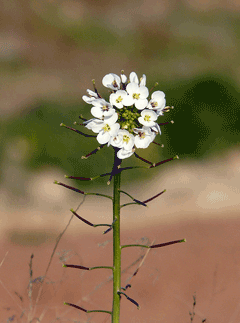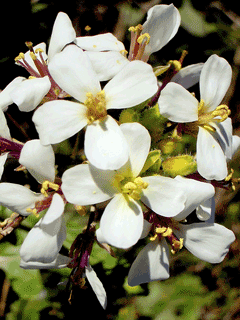 |
|
http://flickr.com/photos/79667341%40N00/ |
 |
| http://flickr.com/photos/79667341%40N00/ |
Translate this page:
Summary
Physical Characteristics

 Diplotaxis erucoides is a ANNUAL growing to 0.5 m (1ft 8in). It is in flower from May to September, and the seeds ripen from June to October. The species is hermaphrodite (has both male and female organs) and is pollinated by Insects.
Diplotaxis erucoides is a ANNUAL growing to 0.5 m (1ft 8in). It is in flower from May to September, and the seeds ripen from June to October. The species is hermaphrodite (has both male and female organs) and is pollinated by Insects.
Suitable for: light (sandy), medium (loamy) and heavy (clay) soils. Suitable pH: mildly acid, neutral and basic (mildly alkaline) soils. It can grow in semi-shade (light woodland) or no shade. It prefers moist soil.
UK Hardiness Map
US Hardiness Map
Synonyms
Brassica erucoides. Sinapis erucoides.
Plant Habitats
Cultivated Beds; East Wall. In. West Wall. In.
Edible Uses
Edible Parts: Leaves
Edible Uses:
Leaves - raw or cooked. A mustard-like flavour, they can be added to salads[217].
References More on Edible Uses
Medicinal Uses
Plants For A Future can not take any responsibility for any adverse effects from the use of plants. Always seek advice from a professional before using a plant medicinally.
None known
References More on Medicinal Uses
The Bookshop: Edible Plant Books
Our Latest books on Perennial Plants For Food Forests and Permaculture Gardens in paperback or digital formats.

Edible Tropical Plants
Food Forest Plants for Hotter Conditions: 250+ Plants For Tropical Food Forests & Permaculture Gardens.
More

Edible Temperate Plants
Plants for Your Food Forest: 500 Plants for Temperate Food Forests & Permaculture Gardens.
More

More Books
PFAF have eight books available in paperback and digital formats. Browse the shop for more information.
Shop Now
Other Uses
References More on Other Uses
Cultivation details
See the plants native habitat for ideas on its cultivation needs[K]. This species is a serious weed in S. Europe[17]. Plants often germinate in the autumn and survive as an over-wintering rosette[17].
References Carbon Farming Information and Carbon Sequestration Information
Temperature Converter
Type a value in the Celsius field to convert the value to Fahrenheit:
Fahrenheit:
The PFAF Bookshop
Plants For A Future have a number of books available in paperback and digital form. Book titles include Edible Plants, Edible Perennials, Edible Trees,Edible Shrubs, Woodland Gardening, and Temperate Food Forest Plants. Our new book is Food Forest Plants For Hotter Conditions (Tropical and Sub-Tropical).
Shop Now
Plant Propagation
Seed - best sown in situ as soon as it is ripe, though it can also be sown in situ in the spring. The seed usually germinates in the autumn.
Other Names
If available other names are mentioned here
Native Range
TEMPERATE ASIA: Saudi Arabia, Yemen, Egypt (Sinai), Iran (west), Iraq, Israel, Jordan, Lebanon, Syria EUROPE: Italy (incl. Sardinia, Sicily), Spain (incl. Baleares), France (incl. Corsica), Portugal AFRICA: Algeria (north), Egypt, Morocco, Tunisia
Weed Potential
Right plant wrong place. We are currently updating this section.
Please note that a plant may be invasive in one area but may not in your area so it's worth checking.
Conservation Status
IUCN Red List of Threatened Plants Status :

Growth: S = slow M = medium F = fast. Soil: L = light (sandy) M = medium H = heavy (clay). pH: A = acid N = neutral B = basic (alkaline). Shade: F = full shade S = semi-shade N = no shade. Moisture: D = dry M = Moist We = wet Wa = water.
Now available:
Food Forest Plants for Mediterranean Conditions
350+ Perennial Plants For Mediterranean and Drier Food Forests and Permaculture Gardens.
[Paperback and eBook]
This is the third in Plants For A Future's series of plant guides for food forests tailored to
specific climate zones. Following volumes on temperate and tropical ecosystems, this book focuses
on species suited to Mediterranean conditions—regions with hot, dry summers and cool, wet winters,
often facing the added challenge of climate change.
Read More
Expert comment
Author
(L.)DC.
Botanical References
17
Links / References
For a list of references used on this page please go here
Readers comment